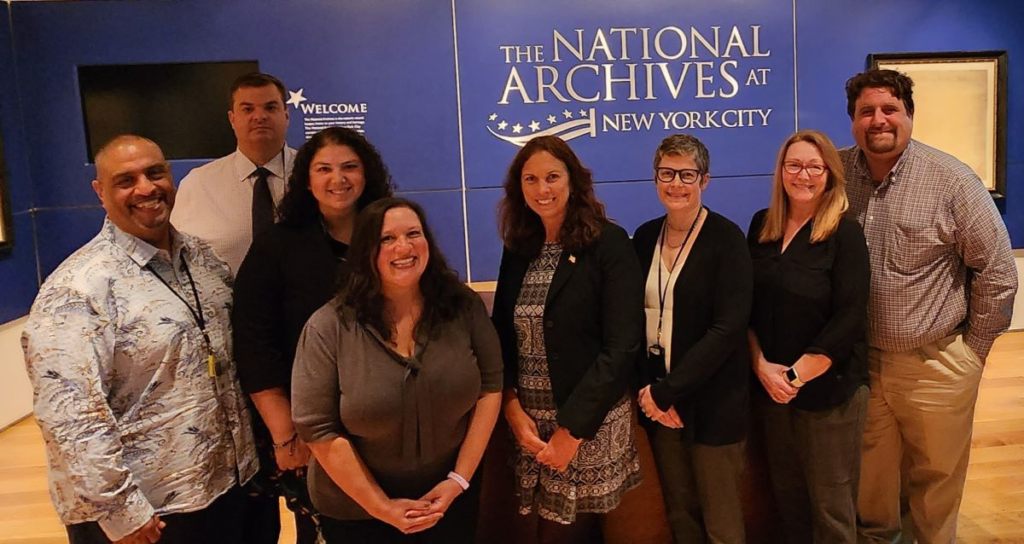
Archivist of the United States Dr. Colleen Shogan traveled to New York City last week to speak at the New-York Historical Society and to visit the National Archives office in lower Manhattan.
Shogan’s visit to New York City kicked off with a Fireside Chat hosted by the New-York Historical Society as part of their Denise and Bernard Schwartz Distinguished Speakers Series and presented jointly with the National Archives Foundation. Soledad O’Brien, journalist and National Archives Foundation Board of Directors member, moderated the chat.
In front of a full auditorium and more than 600 virtual attendees, Shogan and O’Brien discussed everything from the Archivist’s nomination process to Shogan’s role at the National Archives to born-digital records. Shogan stressed the importance of access.
“I’m going to focus a lot, as the Archivist, on access,” Shogan said. “And that means improving in-person experiences at the National Archives, if you come and see us and you want to look at our records as a visitor, as a tourist.”
She continued by discussing the importance of digital access and the online experience.
“We hope that everybody will come visit us in person, but we know that’s not realistic,” Shogan said. “It’s a big trip to get to DC, one of the records centers, or a presidential library, so we have to provide those records online … We have close to 300 million records in our Catalog, which is amazing, making the National Archives the largest digital archive in the world.”
The next day, Shogan visited the National Archives at New York City, located in the Alexander Hamilton U.S. Custom House. That office holds permanent records created by federal courts and agencies for New York, New Jersey, Puerto Rico, and the U.S. Virgin Islands.
Dr. Shogan in the rotunda of the Alexander Hamilton U.S. Custom House.
Archivist Kelly McAnnaney and Virtual Programs Director Dorothy Dougherty took Shogan and Senior Advisor to the Archivist Ellis Brachman on a tour of the New York office’s spaces in the Custom House, as well as other notable areas in the historic building, including the Collector’s Suite.
Staff also shared highlights from the New York holdings. Records on view in the Special Projects Room included a Customs Bureau Personal History of Employees volume that documents the appointment of explorer Matthew Henson, Records from the Puerto Rico Reconstruction Administration (RG 323), and an attorney roll that lists the names of individuals who were eligible to practice law before the United States District Court for the District of New York (Aaron Burr and Alexander Hamilton are both listed).
“We have heavily requested records, like petitions for naturalization, and some very famous records, like the original plans for the Statue of Liberty and the RMS Titanic limitation of liability court case,” explained McAnnaney. “The New York office’s lesser-known holdings are equally important, however, because they reveal how the federal government worked and how various programs played out at the local level.”
McAnnaney cited the War Manpower Commission Regional Central Files, indicative of similar records held at other National Archives locations, that help tell the story of how the government recruited workers during World War II.
The office is one of 42 National Archives locations across the country. It features a Welcome Center, Learning Center, and Research Room, as well as exhibits throughout the Custom House’s public spaces.
The Learning Center hosts educator professional development sessions and student field trip visits with a focus on themes, such as “Civil Rights” and “Exploring America’s Diversity,” as well as “Student Hands-On Archives” programs.

Exhibits can be found in the Welcome Center, the New York on the Record Gallery, and all through the Custom House. Current exhibits include Matthew Henson: From the North Pole to the Custom House, located near the Rotunda, and Be it Remembered, which explores treaties with Native nations and was developed in partnership with the Smithsonian’s National Museum of the American Indian, who share space in the building.
“A lot of my first four months as Archivist has involved learning about the archives itself and also traveling to meet staff and visit as many facilities as possible, so I really can understand both the breadth and depth of the National Archives,” said Shogan. “It was terrific to meet the staff here, to see their notable holdings, like the Susan B. Anthony indictment for illegal voting, and to see the exceptional Custom House.”
The National Archives at New York City is located in lower Manhattan near Battery Park. The research room is open Monday–Friday. Appointments are required.
Follow Dr. Shogan on her official platform accounts:
